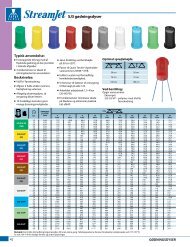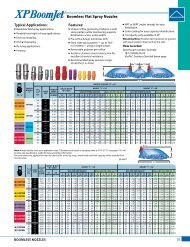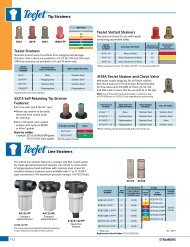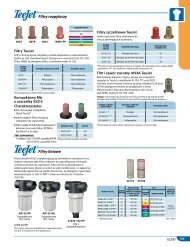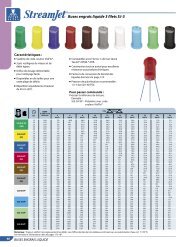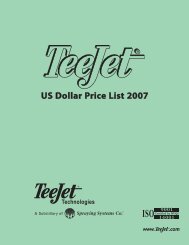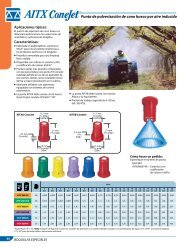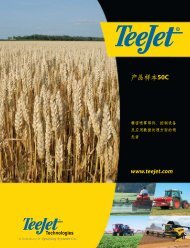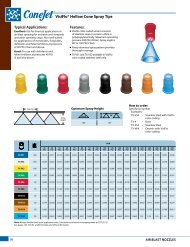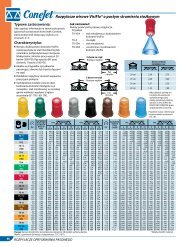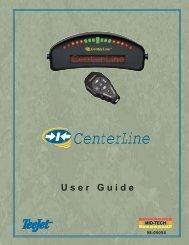Create successful ePaper yourself
Turn your PDF publications into a flip-book with our unique Google optimized e-Paper software.
Electric Regulating Valves<br />
DirectoValve® Electric<br />
Pressure Regulating Valves<br />
The proper regulating valve will enhance<br />
the operation of a sprayer, especially one<br />
with an automatic rate controller. While<br />
advanced electronics provide features<br />
and control, the proper regulating valve<br />
helps the system to respond quickly to<br />
input changes and functions over a wide<br />
range of application rates. Choosing the<br />
proper valve involves determining the<br />
maximum capacity required, the range<br />
of application rates and the proper<br />
motor speed.<br />
System Capacity<br />
A regulating valve’s system requirements<br />
will depend on the application amount<br />
and the pumping capacity. Additionally,<br />
the regulating valve can be used in bypass<br />
or throttling mode. In throttling mode,<br />
the flow through the valve will be applied<br />
through the nozzles. In bypass mode, the<br />
excess flow from the pump is recirculated.<br />
A valve that works well throughout the<br />
flow spectrum has the best chance to<br />
work in all situations.<br />
Types of Regulating Valves<br />
Special ball shapes make regulating valves<br />
more responsive and able to work with<br />
both high and low application rates.<br />
Most agricultural sprayers use either a<br />
% of Maximum Flow<br />
Regulating Valve Flow Curves<br />
100<br />
90<br />
80<br />
70<br />
60<br />
50<br />
40<br />
30<br />
20<br />
10<br />
0<br />
PR Ball<br />
RL Ball<br />
R Ball<br />
Butterfly<br />
2-way ball valve or butterfly valve for<br />
regulating purposes. When considering<br />
sizing a regulating valve, the first concern<br />
is to understand the valve’s flow curve<br />
to determine how efficiently the valve<br />
will regulate. Figure 1 shows typical flow<br />
curves for DirectoValve® regulating type<br />
valves. This will help to decide the type<br />
of valve to use.<br />
0 10 20 30 40 50 60 70 80 90 100<br />
% of Travel<br />
(Figure 1)<br />
R Type Valve<br />
Butterfly Valve<br />
RL Valve<br />
PR Valve<br />
R Type and Butterfly Valves<br />
As shown on the graph, the butterfly valve<br />
has the most non-linear flow curve for final<br />
1/3 (30°) of travel leading to an increase of 75%<br />
in flow through the valve. The straight 2-<br />
way “R” ball curve is not quite as steep, with<br />
the flow through the valve increasing by<br />
60% over the last 30° of travel. The “R” ball,<br />
however, has the additional disadvantage<br />
of not allowing significant flow during the<br />
first 1/3 of its rotation. Since a small change<br />
of rotation causes a significant change using<br />
these valves, trying to regulate large flows<br />
when the valve is two thirds to full open<br />
presents a challenge.<br />
RL Valve<br />
Spraying Systems Co.® has developed a<br />
special ball that allows the valve to start<br />
regulating earlier thus extending the<br />
regulating range. This special ball valve also<br />
increases flow and the linear characteristic of<br />
the valve during the first 3/4 of the valve cycle.<br />
The flow from the valve starts 10º earlier,<br />
than a regular R type ball and increases the<br />
flow of the RL ball during the first 70% of<br />
travel (Figure 1). The maximum capacity is<br />
about 10% less than an R type valve.<br />
Ball Type Regulating Valves<br />
model number<br />
344BR-2<br />
344BR-3<br />
344BRL-2<br />
* 344BPR-2<br />
* 344BPR-3<br />
346BR-2<br />
346BR-3<br />
* 346BPR-2<br />
* 346BPR-3<br />
PR Valve<br />
The PR valve uses a 3-way valve body and a<br />
ball with a wedge removed. The combination<br />
of this ball and a motor that rotates past<br />
the standard 90º results in a valve with an<br />
almost linear flow curve. The 2PR version has<br />
one outlet plugged. The 3PR version allows<br />
bypass flow to return to the tank.<br />
As noted in Figure 1, the percentage of flow<br />
increases by approximately the amount of ball<br />
travel thus avoiding the rapid change seen<br />
with standard ball valves and butterfly valves.<br />
* Not available in stainless steel.<br />
MAXIMUM PRESSURE<br />
FLOW RATE AT A 5 PSI (0.34 bar)<br />
PRESSURE DROP<br />
300 PSI (20 bar) 32 GPM (121 l/min)<br />
300 PSI (20 bar) 24 GPM (91 l/min)<br />
300 PSI (20 bar) 27 GPM (102 l/min)<br />
300 PSI (20 bar) 12 GPM (45 l/min)<br />
300 PSI (20 bar) 12 GPM (45 l/min)<br />
150 PSI (10 bar) 100 GPM (379 l/min)<br />
150 PSI (10 bar) 64 GPM (242 l/min)<br />
150 PSI (10 bar) 53 GPM (200 l/min)<br />
150 PSI (10 bar) 53 GPM (200 l/min)<br />
VALVES AND MANIFOLDS<br />
73






